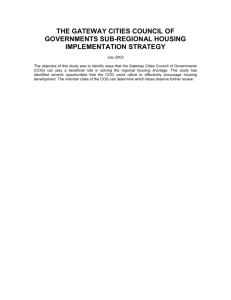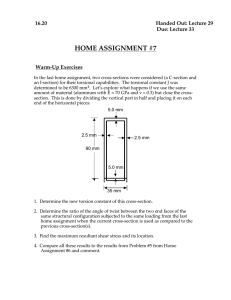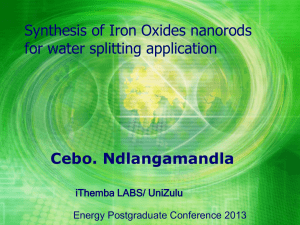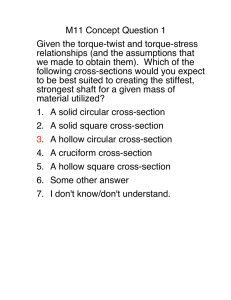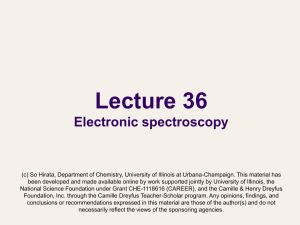Photoionization Cross-sections
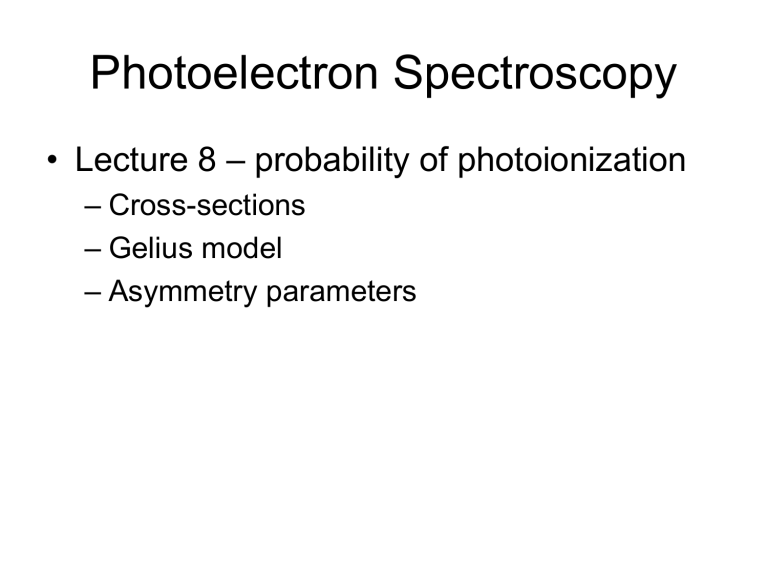
Photoelectron Spectroscopy
• Lecture 8 – probability of photoionization
– Cross-sections
– Gelius model
– Asymmetry parameters
Ionization is still a transition between states
• Initial State: Neutral (or anion)
• Final State: Atom/Molecule/Anion after an electron is removed, plus the ejected electron
• M → M + + e-
init
= M
final
= M + + e-
• Transition Probability = ∫ init m
final d
• For direct photoionization, transition probability is always > 0
• Photoionization probability is typically described in terms of a cross-section (much more on this later)
Photoionization Cross-section
• The probability per unit area, per unit time that a photon of a given energy can be absorbed by an atom to excite the photoelectrons.
– Fictitious area representing the fraction of incoming photons that will be absorbed in the photoionization process.
cross-section
( h
)
P ( h
I ( h
)
)
# photons absorbed per unit time incident photon flux
– Unit: barn (10 -24 cm 2 ) or megabarn (10 -18 cm 2 )
Partial Photoionization Cross-sections
• If more than one orbital level is excited, then the cross-section becomes the summation of partial photoionization cross-sections (PPCS)
tot
nl
nl
– PPCSs are a function of the photoelectron’s kinetic energies, and therefore are a function of the incident photon energies.
• When PPCS is measured at a specific angle, it is called a differential cross-section, d σ/d
, which is related to σ nl by an asymmetry parameter,
(h
) d
( hv nl d
)
4
nl [ 1
1
4
( hv )( 3 cos
2
1 )]
– This specific equation is for a randomly-oriented ensemble of atoms in an unpolarized field.
Calculated atomic orbital ionization cross-sections
J.J. Yeh and I. Lindau, At. Data Nucl. Data Tables 1985, 21, 1.
So far we’ve only talked about atoms; what about molecules?
Gelius model: cross-section behavior of molecular orbitals is dependent on the atomic orbital character from which the
MO is comprised.
(Gelius and Siegbahn, Faraday Discuss. Chem.
Soc., 1972, 257.)
Variable photon synchrotron studies: Green has collected data on ferrocene at 25 different photon energies from 20-120 eV.
Branching Ratios:
Ratio of band intensities as a function of photon energy.
“Photoionization Cross-Sections: A Guide to Electronic Structure”,
J. C. Green and P. Decleva, Coord. Chem. Rev. 2005, 249, 209-228.
He I
Ferrocene
2 E
1g
2 E
1u
2 A
1g
2 E
2g
He II
15 13 11 9
Ionization Energy (eV)
7
Electronic Structure of Ferrocene
What is the point group?
Looking down the Cp-Fe-Cp vector:
Cp’s can lie in two extreme conformations:
Fe eclipsed
D
5h d orbitals transform as: a
1
’, e
1
’, e
2
’ staggered
D
5d d orbitals transform as: a
1g
, e
1g
, e
2g
We’re going to use these labels
Cp (D
5h
)
Metallocene Ligand
Group Orbitals
(Cp)
2
2-
(D
5d
) e
2g e
1u a
1g e
2u e
1g a
2u
Cp e
2
" e
1
" a
2
"
(Cp)
2
2e
2u e
2g e
1g e
1u a
2u a
1g
(Cp)
2
M e
1u a
2u e
2g
* a
1g e
2u e
1g
* a
1g e
2g
e
1u e
1g a
2u a
1g
M 2+
4p
(a
2u
+e
1u
)
4s a
1g
3d
(a
1g
+e
1g
+e
2g
)
= 180 °
Asymmetry Parameters
= 90 °
= 54.73
°
= 0 °
Photoelectron Imaging
CS
2
photoelectron images
(Abel inverted)
54.73
800 nm
400 nm
